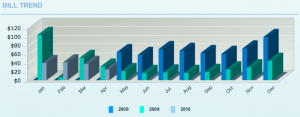This storefront in Estes Park, Colorado paints an interesting picture of what the kids are wearing these days:
Month: May 2010
Charles Darwin on Twitter
I normally despise all things pertaining to Twitter, so it has perhaps taken me longer than others to discover that Charles Darwin is on Twitter now.
The posts are a real-time account (time delayed 176 years) of Darwin’s travels, culled from the Beagle Diary and from other journals, notes, et cetera that Darwin left for posterity. Upon first following the link I expected to find satire, but the reality is so much more interesting. It’s actually possible to get a sense of Darwin’s thoughts and the timeline of his voyage.
These sad updates, for example, were posted on April 7th:
What will become of me hereafter, I know not; I feel, like a ruined man, who does not see or care how to extricate himself
It is a comfortable reflection to me, that a ship – being made of wood & iron – cannot last for ever & so this voyage must have an end.
Behind the scenes of this delightful operation is David from metaburbia, a software developer in the United Kingdom.
Can You Hear Me Now?
This story appeared today on Yahoo! News:
Wouldn’t an even more impressive story have been about the earlier climber who, after ascending Mount Everest, built a cellular phone tower?
(It was actually a satellite phone, but it’s funnier to think of a cellular tower atop Everest.)
Blast Off!
Tonight began like so:
Sophie: Can we play dolls? Please, please can we play dolls?
No. No, we cannot.
Instead, we took my globe off the bookcase and played the classic “spin it and point to a place” game. When the real globe got boring, we switched to Google Earth, and zoomed into Street View in each of the places Sophie picked. Thus we had a little world geography lesson combined with fancy computer graphics to occupy our imaginations.
Next we switched to my lunar globe and naturally started talking about how people have walked on the moon. This naturally lead to YouTube videos and footage from Apollo 13 of Saturn V liftoffs, men bouncing across an alien surface, and ocean splashdowns.
Tonight ended like so:
Sophie: (running down the hall with a kite in tow) 5… 4… 3… 2… 1… blast off!
Now we’re talkin’.
Mostly at Night
Sophie, upon waking up from a dream (in a matter-of-fact tone):
Do aliens come at night or in the morning?
Of course, everyone who’s seen the movie Aliens knows the answer. In Newt’s own words, “They mostly come at night… mostly.”
Extensive Stripper Research
I’ve started getting caught up on season 5 of Doctor Who, and (of course) reading about it on Wikipedia at the same time. Since The Doctor’s new companion works as a “kiss-o-gram” at the beginning of the first episode, one thing naturally lead to another, and I landed on the Strip-o-gram article.
This type of entertainment became popular in the 1970s…. Exact dates are difficult to ascertain however, as there does not appear to have been any major research carried out on the subject.
Wait, should there have been major research on the subject? Should there have been any research on the subject?
(And in case you were wondering, my fianceé did indeed see this post when all I’d written was “Extensive Stripper Research,” and now I’m in trouble.)
Highway Robbery?
A week ago, two movers from Mayflower Transit came to my apartment to load my belongings onto a clearly-branded Mayflower Transit truck (shown at right driving down Commonwealth Avenue).
This afternoon, a driver from United Van Lines called to inform me he’d be dropping off my belongings at our new apartment.
So, at some point between Boston and Colorado, did you two meet up and swap? Did the United driver hijack the Mayflower truck partway here? Or did you just repaint the truck en route?
Through deep and detailed research (i.e., reading one Wikipedia article) I now know that both are owned by the same parent company, but that doesn’t make the initial phone call any less confusing.
Xcel’s Graph
Our new provider of heating gas in Colorado is Xcel Energy. They have an elaborate Flash-based website for customers which includes this graph of usage history:
I see three key problems here.
First, the “3D” effect is widely known to distort perceptions of data. It’s too easy, for example, to see those last two dark bars as depicting similar magnitudes since the leading edge of one is so close to the trailing edge of the other. This chart has a single dimension of data (“cost”), so it needs a one-dimensional presentation. “Pretty” is confusing — what Edward Tufte calls “chartjunk.”
Second, the chart overlaps data from three years, emphasizing comparisons between costs in the same month of different years, while making the long-term trend difficult to identify. Are we actually spending less this year than last? This arrangement of data is particularly troubling since peak usage is naturally in the winter, which always spans two calendar years. Having so much historical data is a privilege; let’s see it all laid out chronologically.
Finally, what’s plotted is not actually “usage” at all, but “cost.” It’s impossible to tell from this chart alone whether we used less energy this year or if rates fell. In fact, our dramatically higher costs in 2008 were from a previous residence where Xcel provided both gas and electricity. The cost was higher, even if our gas usage was lower. We need charts that show our energy usage (in kilowatt hours or in cubic meters, as appropriate), not how much money we’ve spent.



